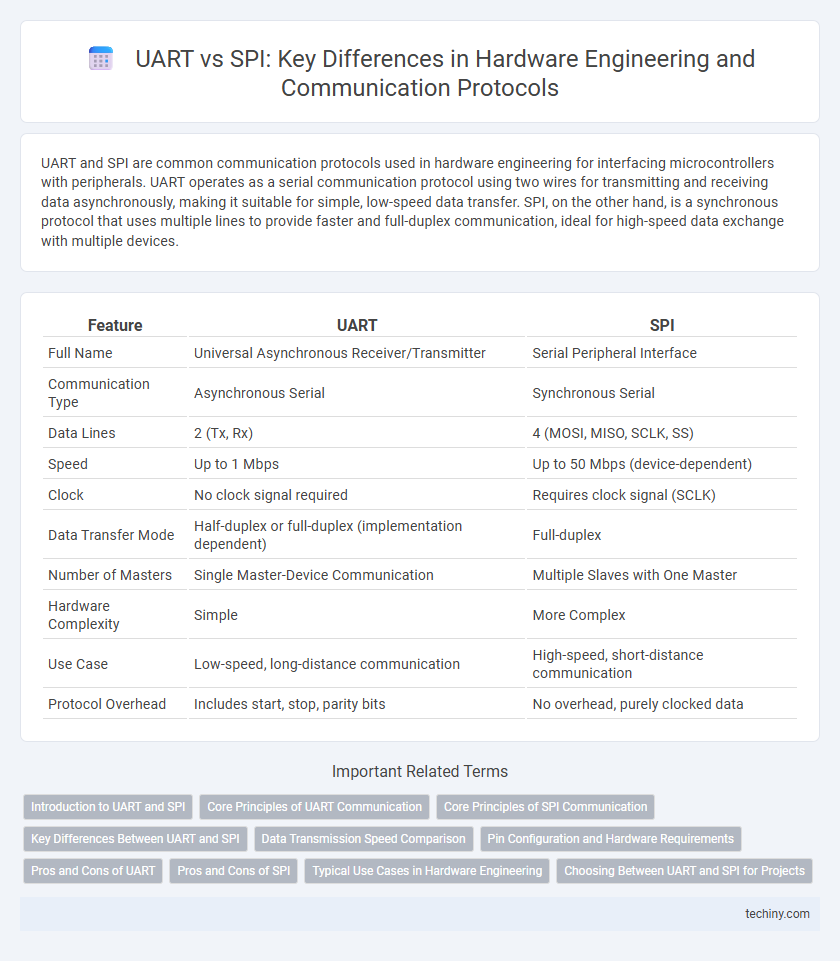UART and SPI are common communication protocols used in hardware engineering for interfacing microcontrollers with peripherals. UART operates as a serial communication protocol using two wires for transmitting and receiving data asynchronously, making it suitable for simple, low-speed data transfer. SPI, on the other hand, is a synchronous protocol that uses multiple lines to provide faster and full-duplex communication, ideal for high-speed data exchange with multiple devices.
Table of Comparison
| Feature | UART | SPI |
|---|---|---|
| Full Name | Universal Asynchronous Receiver/Transmitter | Serial Peripheral Interface |
| Communication Type | Asynchronous Serial | Synchronous Serial |
| Data Lines | 2 (Tx, Rx) | 4 (MOSI, MISO, SCLK, SS) |
| Speed | Up to 1 Mbps | Up to 50 Mbps (device-dependent) |
| Clock | No clock signal required | Requires clock signal (SCLK) |
| Data Transfer Mode | Half-duplex or full-duplex (implementation dependent) | Full-duplex |
| Number of Masters | Single Master-Device Communication | Multiple Slaves with One Master |
| Hardware Complexity | Simple | More Complex |
| Use Case | Low-speed, long-distance communication | High-speed, short-distance communication |
| Protocol Overhead | Includes start, stop, parity bits | No overhead, purely clocked data |
Introduction to UART and SPI
UART (Universal Asynchronous Receiver/Transmitter) is a communication protocol used for asynchronous serial communication, transmitting data byte-by-byte with start and stop bits for synchronization. SPI (Serial Peripheral Interface) operates as a synchronous serial communication protocol, utilizing a master-slave architecture with clock, MOSI, MISO, and SS lines to enable full-duplex data exchange. Both UART and SPI are fundamental interfaces in hardware engineering for connecting microcontrollers to peripheral devices, with distinct advantages in speed, complexity, and communication methods.
Core Principles of UART Communication
UART communication transmits data serially using asynchronous signaling with a start bit, data bits, optional parity bit, and stop bits to frame each byte. It relies on fixed baud rates for timing synchronization between the transmitter and receiver without a shared clock line. The core principle emphasizes simple, full-duplex data exchange over two wires--transmit (TX) and receive (RX)--enabling straightforward, low-pin-count serial communication.
Core Principles of SPI Communication
SPI communication operates on a full-duplex, master-slave architecture, utilizing separate lines for data transmission (MOSI), data reception (MISO), clock (SCLK), and slave selection (SS). It relies on a synchronized clock signal generated by the master to ensure precise timing and data integrity during transmission. Unlike UART, SPI supports higher data rates and simultaneous bidirectional data flow, making it ideal for high-speed sensor and peripheral interfacing in hardware engineering.
Key Differences Between UART and SPI
UART uses asynchronous serial communication with a single data line for transmission and reception, enabling point-to-point connections ideal for simple, low-speed data exchange. SPI operates synchronously with separate data lines for input, output, clock, and chip select, supporting high-speed, full-duplex communication suited for multi-device networks. UART's data framing involves start and stop bits, while SPI relies on clock pulses for data synchronization, resulting in varied timing and hardware complexity.
Data Transmission Speed Comparison
UART typically supports data transmission speeds up to 1 Mbps, making it suitable for low to moderate speed communications in embedded systems. In contrast, SPI can achieve much higher speeds, often exceeding 50 Mbps, due to its synchronous clock-driven data transfer mechanism. This makes SPI preferable for applications requiring rapid data exchange and high throughput between microcontrollers and peripheral devices.
Pin Configuration and Hardware Requirements
UART requires only two pins for communication: one for transmission (TX) and one for reception (RX), simplifying hardware connections. SPI demands at least four pins--MOSI, MISO, SCLK, and SS--enabling full-duplex data transfer with precise clocking control. Hardware design for SPI involves additional complexity due to multiple slave select lines and synchronous clock management, unlike UART's asynchronous serial communication.
Pros and Cons of UART
UART offers simple, cost-effective communication with minimal wiring and easy implementation for short-distance, low-speed data transfer in embedded systems. It lacks a clock signal, causing potential timing issues and limited synchronization compared to SPI, which can impact data integrity in noisy environments. UART's lower data rates and half-duplex communication restrict its use in high-speed, full-duplex applications requiring precise timing.
Pros and Cons of SPI
SPI offers high-speed data transfer rates up to several MHz, making it ideal for applications requiring fast communication between microcontrollers and peripherals. It supports full-duplex communication and multiple slaves with separate chip select lines, providing flexibility in system design. However, SPI requires more GPIO pins than UART and lacks standardized error detection, which can complicate wiring and data integrity.
Typical Use Cases in Hardware Engineering
UART is commonly used for serial communication between microcontrollers and peripheral devices like GPS modules, sensors, and Bluetooth modules due to its simplicity and asynchronous data transfer. SPI is favored in hardware engineering for high-speed data exchange with devices such as flash memory, ADCs, and displays, offering synchronous communication with multiple slave devices. Engineers choose UART for long-distance, low-pin-count connections and SPI for applications requiring faster data rates and precise timing control.
Choosing Between UART and SPI for Projects
Selecting between UART and SPI depends on project requirements such as speed, distance, and complexity of communication. UART is ideal for simple, low-speed, point-to-point serial communication with minimal wiring, making it suitable for devices like GPS modules. SPI offers higher data rates and supports multiple devices via chip select lines, making it preferable for sensor arrays and memory devices requiring fast, synchronous data transfer.
UART vs SPI Infographic

 techiny.com
techiny.com